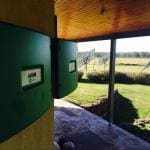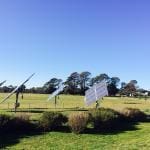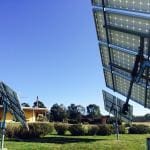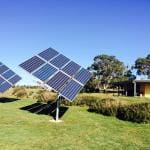Solar panels at a retreat centre in the Shoalhaven area are still going strong after 4 years of operation. The property where the installation lives, named Oallen, sits near the Shoalhaven Riven near a crossing called Oallen Ford. At one time a farm holiday retreat, the spot is now leased out as a long-term rental and is home to a visually stunning set of sun-tracking solar arrays. Standing prominently in the backyard, the 4 towering panel arrays follow the sun across the sky throughout the day, delivering for the centre an exceptionally favourable return on investment thanks to the 60¢/kWh gross solar feed-in tariff incentive that they receive.
There are a number of aspects of the system that make this system stand out from the vast majority of those in the rest of the state and the country. Its interesting characteristics are also indicative of the period in which it was constructed. Installed in 2010–a time when most systems were in the much smaller 1kW-1.5kW range–it would have been ahead of its time with a total capacity of 5.6kW.
Nowadays, most solar systems in the 5kW range are affordable enough that any concerns about generation inefficiencies associated with stationary roof-mounting would not usually warrant an investment in a tracking system, especially where open space is limited. But back in 2010, when the cost of installing a solar PV system was up to 4x more than what it is today–and solar modules were the most expensive components in a system–the argument that one should do everything possible to get the most out of every watt was even more compelling.
The owner says that the system produces 31.3kWh per day, which is about about 36% more power than it would otherwise generate if it were fixed in one place. The tracking system is time-based, following the sun throughout the sky during the day on a pre-programmed algorithm instead of moving in response to the sun.
Another reason that solar tracking is not the norm these days is that the introduction of moving parts potentially makes a solar system more susceptible to the forces of nature than their stationary, fixed-frame counterparts. The arrays at Oallen have nevertheless proved themselves to be incredibly resilient and durable, surviving a number of epic storms intact, including one in late June where wind speeds exceeded 100km/hr. Although some of the steel cross-struts did fracture under the pressure, all welding points have held firm.
Also noteworthy as a throwback to a bygone era–and a reminder about how quickly the Australian solar scene has changed–are the panels and inverters used in the system, both of which are branded as BP Solar. At one time, BP Solar was the only manufacturer of solar panels in Australia. The company, long a prominent player in the Australian market, eventually decided to shutter its PV operations globally. Their factory was at a later date taken over by Silex Solar until Silex also left the PV manufacturing industry, only to be supplanted by Tindo Solar as the only Australian panel manufacturer thereafter.
The 60¢/kWh gross feed-in tariff rate that the system is tapped into (and will continue to receive until 2016) is also a legacy from another age. Given the high costs associated with a solar system back then (easily $5/W or more vs $2/W or less today), the NSW government at the time introduced an extraordinarily generous incentive to goad the state’s solar industry into what was ultimately an unsustainable boom. Ordinary households across the state jumped to take advantage of the incentive, which made going solar a ‘no-brainer’. The owners of Oallen knew that electricity prices were only going to continue rising. Riding the wave of solar uptake that swept the state during this ‘golden age’ of NSW solar, they have not had to pay an electricity bill since the system was installed–and in fact receive a cheque from their electricity retailer at the end of each year for the power their system has sent into the grid.
The now notorious Solar Bonus Scheme, generally considered by all sides to have been a badly-executed policy, did serve the purpose of kickstarting NSW’s (and in a way, all of Australia’s) solar industry in a way that may not have happened otherwise. The scheme also played a role in driving down the cost of installations in Australia–where system prices are now among the lowest in the world. Shoalhaven River Retreat, as one of the first to get on board, was certainly a member of the trend-setting generation that took on solar before it was commonplace–back when systems numbered in the hundreds instead of over 1 million.
© 2014 Solar Choice Pty Ltd



